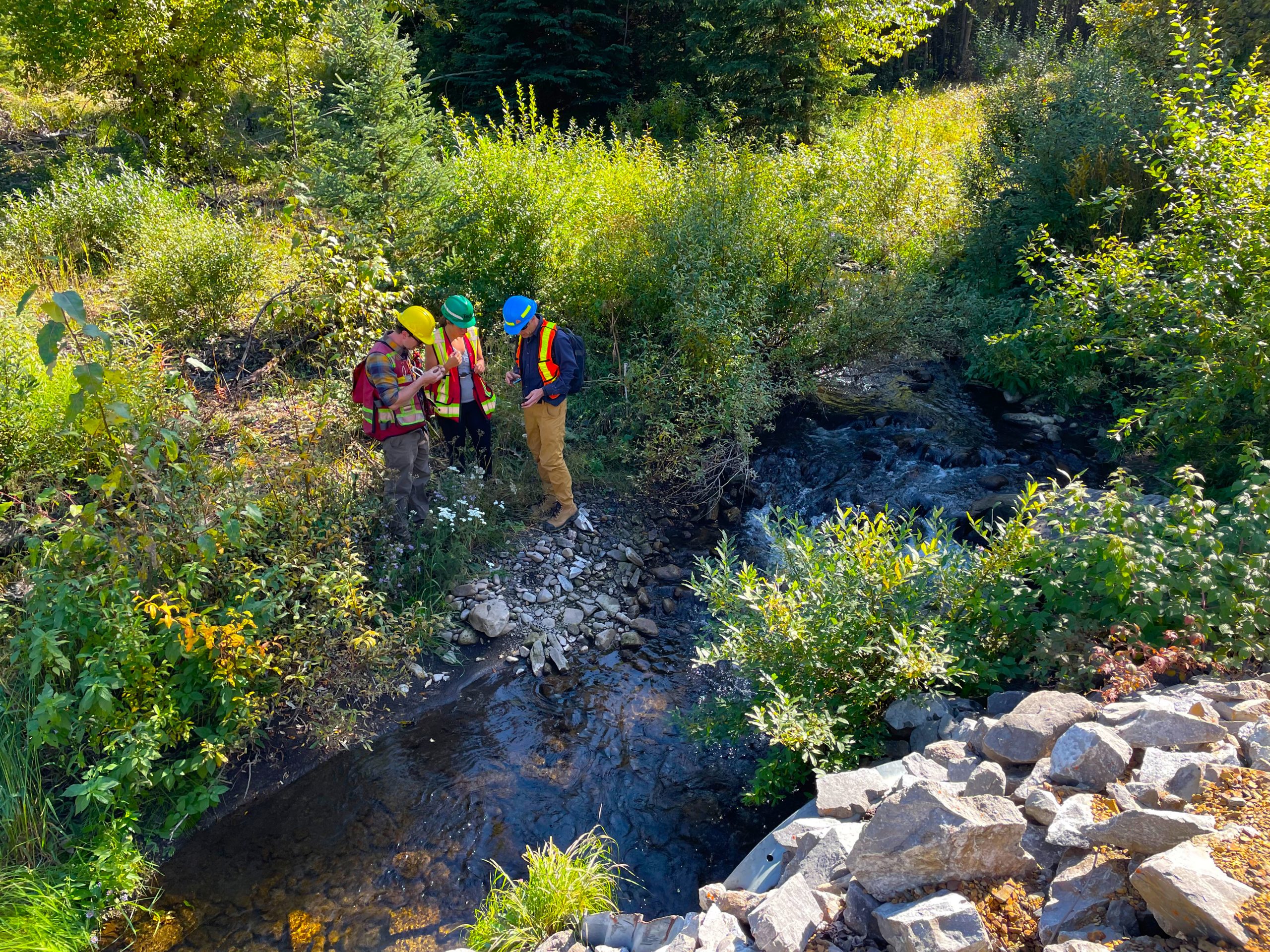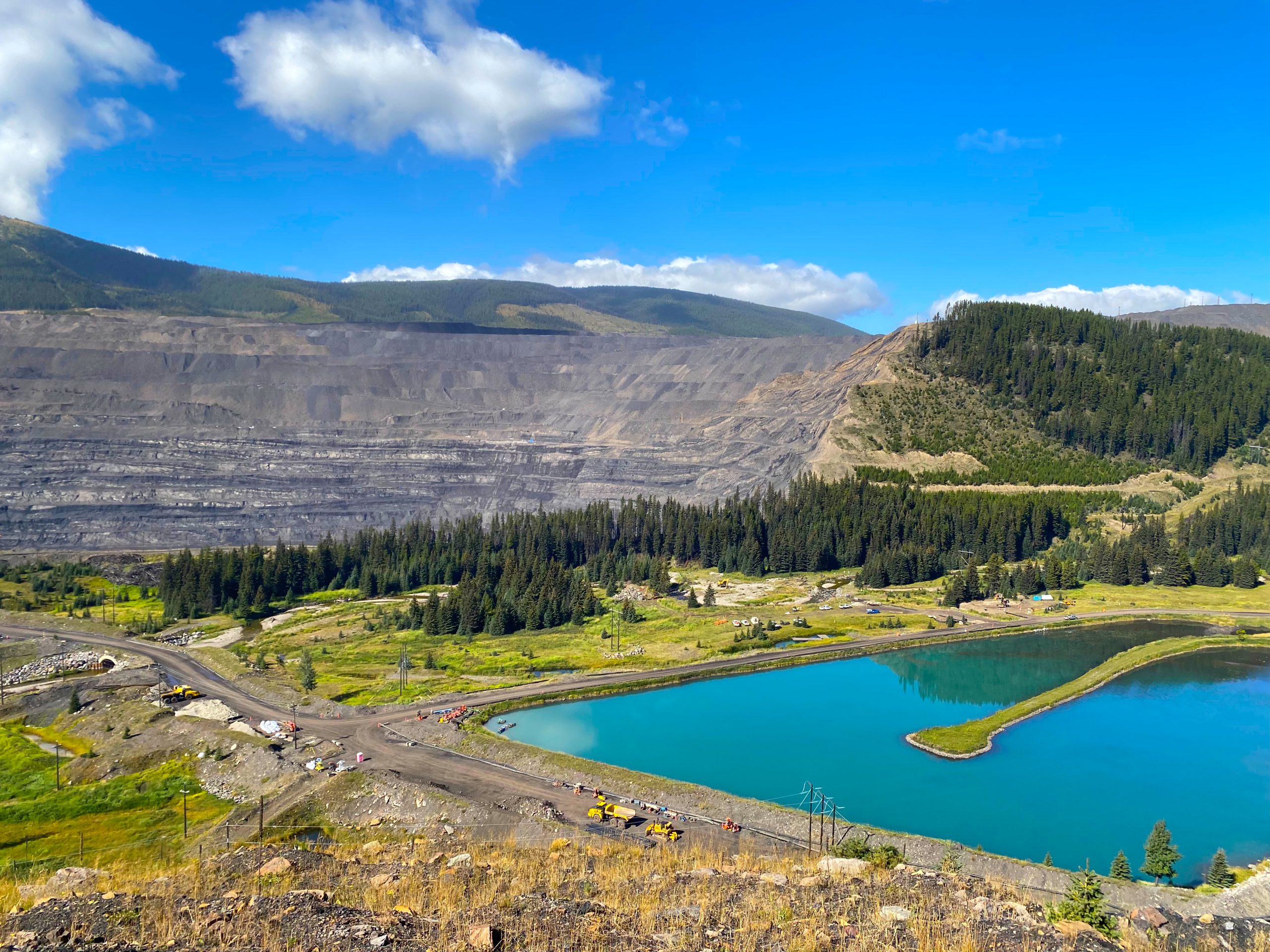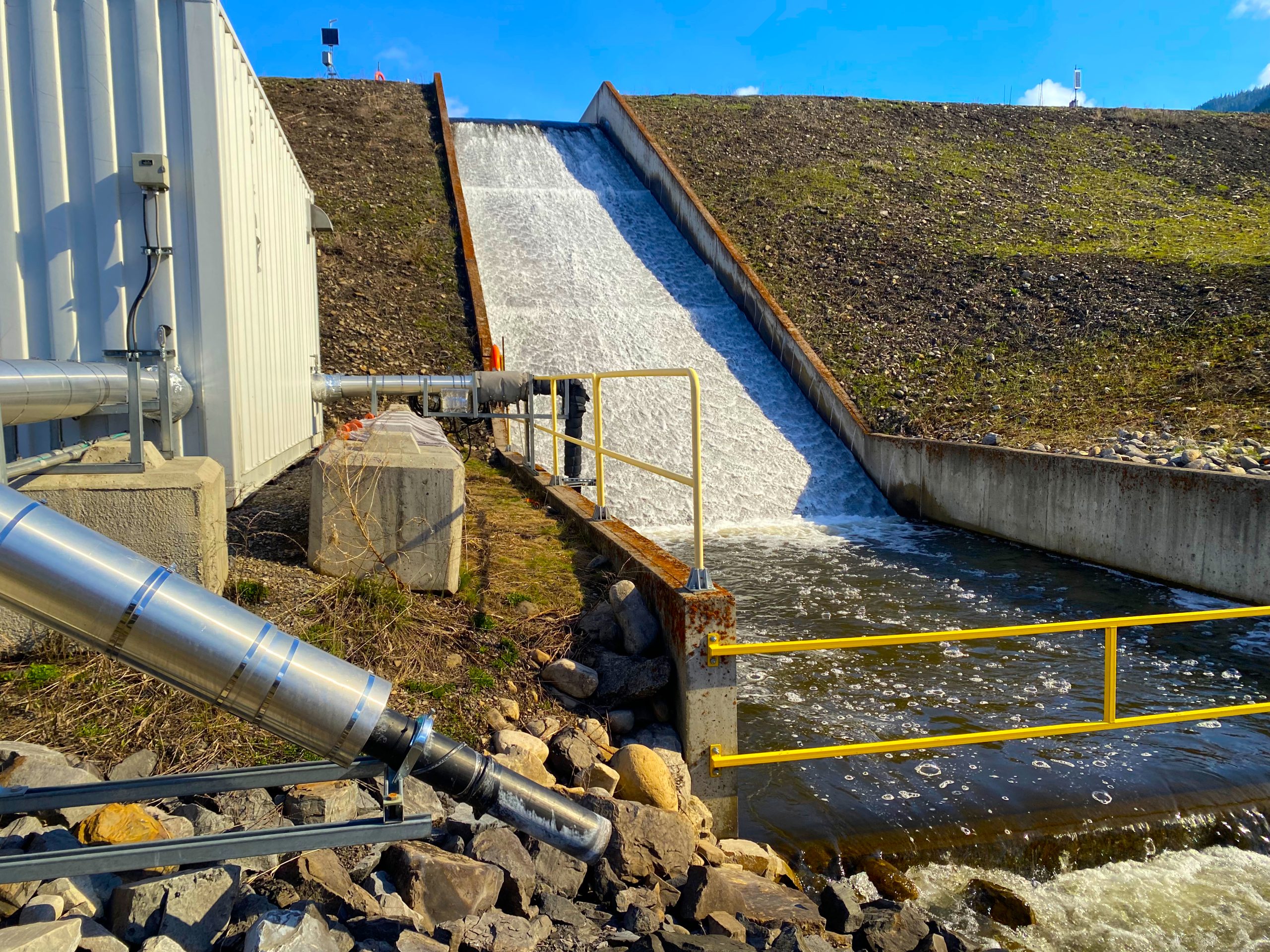Updated November 2023
On this page
At-a-glance summary
Water treatment facility performance summary
| Facility Status: | Operating |
| Facility Name: | West Line Creek Active Water Treatment Facility |
| Max. Treatment Capacity (m3/day): | 7,500 |
| 2022 Average Treatment Rate (m3/day): | 6,762 |
| Total Selenium Removed (kg): | 595 |
| Total Nitrate Removed (kg) | 35,015 |
| Notes: | – |
| Facility Status: | Operating |
| Facility Name: | Elkview Saturated Rock Fill |
| Max. Treatment Capacity (m3/day): | 20,000 |
| 2022 Average Treatment Rate (m3/day): | 11,419 |
| Total Selenium Removed (kg): | 672 |
| Total Nitrate Removed (kg) | 89,292 |
| Notes: | Fording River Operations South Active Water Treatment Facility |
| Facility Status: | Operating |
| Facility Name: | Fording River Operations South Active Water Treatment Facility |
| Max. Treatment Capacity (m3/day): | 20,000 |
| 2022 Average Treatment Rate (m3/day): | 8,064 |
| Total Selenium Removed (kg): | 1,269 |
| Total Nitrate Removed (kg) | 173,831 |
| Notes: | Start-up phase January through June. Operations phase began July 1. |
| Facility Status: | Operating |
| Facility Name: | Fording River North 1 Saturated Rock Fill Phase 2 |
| Max. Treatment Capacity (m3/day): | 30,000 |
| 2022 Average Treatment Rate (m3/day): | – |
| Total Selenium Removed (kg): | N/A |
| Total Nitrate Removed (kg) | N/A |
| Notes: | Operations phase began Dec. 10, 2023 |
Updated: Feb 14, 2024
Highlights
EVR’s strategy for improving water quality in the Elk Valley relies heavily on water treatment. Water treatment is necessary to reduce the impacts of historic and current mining.
A document called the Implementation Plan describes how EVR proposes to add or expand treatment capacity in the Elk Valley. This increased capacity will help EVR achieve water quality limits and meet the goals of the Elk Valley Water Quality Plan. An updated version of EVR’s Implementation Plan was created in 2022.
EVR is also developing and testing options to prevent poor water quality from being generated on their mine sites. This approach is called ‘source control’. It will help reduce reliance on water treatment in the future. In 2022, EVR reduced the amount of selenium, nitrate and sulphate generated from mining by improving mining practices and implementing source control. For example, nitrate release is being reduced by using liners in the holes where explosives are placed for blasting. New waste rock piling techniques are also being tested to reduce the release of all substances into the environment.
As of December 2022, there are four water treatment facilities in the Elk Valley operating or under development:
- Two Active Water Treatment Facilities (AWTF)
- Two Saturated Rock Fills (SRF)
EVR has permits allowing them to treat and discharge up to 77,500 cubic metres per day of water from these facilities.
The three operating facilities (West Line Creek AWTF, Elkview SRF and Fording River South AWTF) are actively removing selenium and nitrate from mine-impacted waters. In 2022 they removed over 90% of the selenium and nitrate from water being treated, for a combined total of 300 tonnes of nitrate and 2.5 tonnes of selenium. Water treatment facilities are monitored to achieve peak performance and to ensure they do not pose a risk to the environment.
A new SRF at Fording River Operations, called the Fording River North 1 SRF, underwent regulatory review in 2022 and early 2023. The facility is now approved and expected to be fully operational by the end of 2023.
The total amount of selenium and nitrate being removed from the watershed through water treatment has been increasing as more treatment facilities come online. Concentrations of selenium and nitrate are stabilizing downstream of the operating facilities and more significant improvements are predicted in the coming years.
The figure below shows how the increasing selenium trend in the Elk River (red dots show measured results) has begun to stabilize since treatment facilities began operating (solid black lines show when facilities began treating water). Modelling predicts that water quality will continue to improve (blue line) as more water treatment facilities begin operating (dashed lines show when new facilities begin treating water). Without these treatment facilities, selenium levels would continue to increase over time (gray line).

Projected concentrations without mitigations were sourced from the 2020 Regional Water Quality Model. Projected concentrations with mitigations were sourced from the 2022 Implementation Plan Adjustment.
View Quarterly Snapshots for current summaries on the status of water treatment.
View current and past water quality results on the Elk Valley Water Quality Dashboard.
Data and details
Treatment facility performance and results
West Line Creek Active Water Treatment Facility

Inside the West Line Creek Active Water Treatment Facility.
The West Line Creek (WLC) Active Water Treatment Facility (AWTF) treats water from West Line Creek and Line Creek up to 7,500 m3/day. The average daily flow through the West Line Creek AWTF in 2022 was 6,762 m3/day for an annual total of 2,467,986 m3. These volumes are the same as 2021 rates and are equivalent to almost 3 Olympic size swimming pools per day.
EVR’s permits assume that facilities operate, and discharge treated water to the environment 95% of the time, with 5% downtime for maintenance and repairs. EVR met this target in 2022.
In 2022, the AWTF removed a total of 595 kg of selenium and 35,015 kg of nitrate. This is similar to the removal in 2021 and generally reflects the annual amounts expected to be removed by this facility.
There were no non-compliances associated with facility operations; however, nitrate non-compliances occurred downstream at the Line Creek Operations compliance point. To continue improving water quality in Line Creek EVR plans to expand this facility by December 31, 2025. The expansion is expected to increase the maximum treatment volume to 17,500 m3/day.
View detailed performance data for this facility.
Elkview Operations Saturated Rock Fill
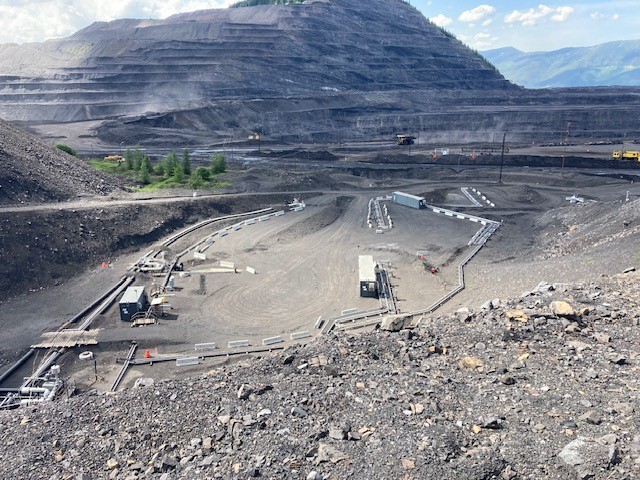
The Elkview Operations Saturated Rock Fill.
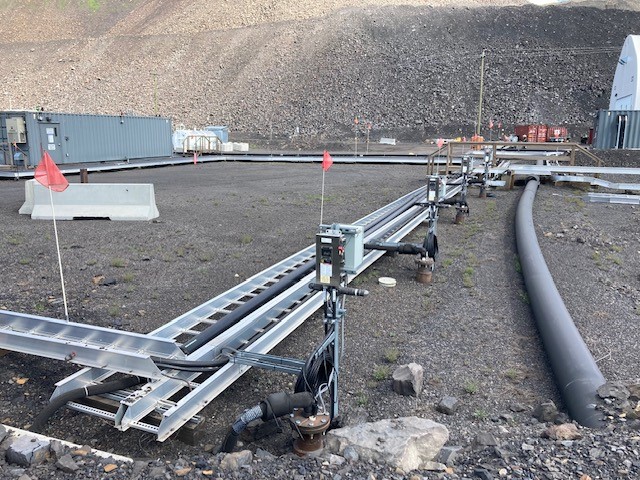
Monitoring wells at the Elkview Operations Saturated Rock Fill.
The Elkview Operations (EVO) Saturated Rock Fill (SRF) treats water from Erickson Creek and Natal Pit up to 20,000 m3/day. The average daily flow through the Elkview SRF in 2022 was 11,419 m3/day, which is roughly 4.5 Olympic size swimming pools per day.
The 2022 treatment volumes were lower than expected because the Erickson Creek source, which is the primary treatment source for this facility, was taken offline from April 9th to October 4th. The shutdown was implemented to fix an apparent flow blockage within the inflow pipeline and to investigate unexpected monitoring results in Erickson Creek. In particular, aquatic insects downstream of the treatment facility outfall showed elevated levels of selenium in their body tissues. By October, the flow restriction was fixed, and the cause of the elevated monitoring results was sufficiently understood to allow the SRF to resume treating Erickson Creek.
In 2022, the SRF removed a total of 672 kg of selenium and 89,292 kg of nitrate, which despite the operational issues described above, still represents notable increases from 2021. EVR continued to improve the performance of the facility outside of the Erickson shutdown period, achieving a new facility high average treatment volume of 16,529 m3/day in January and record daily nitrate removal of 359 kg on November 16th. The treatment facility helped ensure full compliance with nitrate and selenium limits in Michel Creek throughout 2022. Treatment performance is expected to continue to improve in 2023.
EVR is taking steps to address the elevated selenium levels measured in the aquatic insects downstream of the Erickson Creek outfall. Detailed investigations revealed that a combination of SRF derived particulate and unique aquatic plants growing immediately downstream of the discharge were interacting to enhance the accumulation of selenium in aquatic insects. The effect was limited to immediately downstream of the discharge. Long term solutions to permanently address this issue will continue to be advanced in 2023.
View detailed performance data for this facility.
Fording River Operations South Active Water Treatment Facility
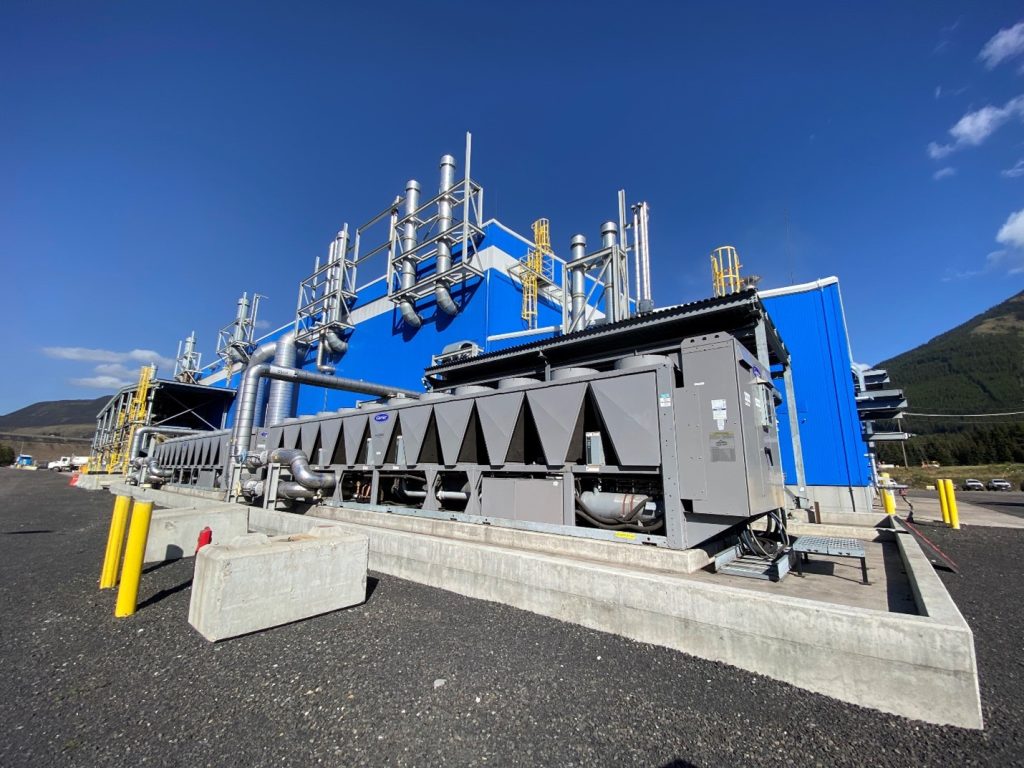
Water chillers at the Fording River Operations South Active Water Treatment Facility.
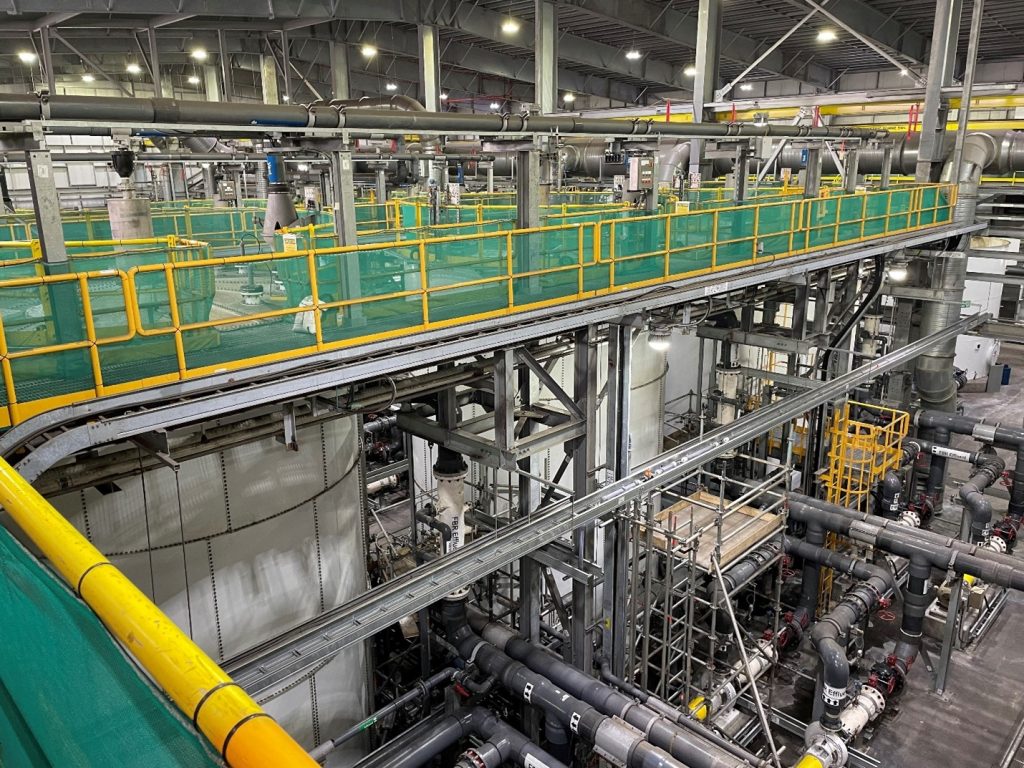
Inside the Fording River Operations South Active Water Treatment Facility.
The Fording River Operations South (FRO-S) Active Water Treatment Facility (AWTF) is the Elk Valley’s newest fully operating treatment facility. It began discharging treated water to the environment on December 22, 2021, and completed its start-up phase on July 1, 2022. The facility treats water from both Swift and Cataract Creeks (preferentially) as well as Kilmarnock Creek, up to a maximum capacity of 20,000 m3/day.
Treatment volumes slowly increased throughout the facility start-up and early operations phases in 2022, peaking at 17,333 m3/d on September 23rd. Treatment volumes then declined from October through December as treatment became limited by the reduced amount of available water in Swift, Cataract and Kilmarnock creeks. Overall, the facility treated an average of 8,064 m3/day in 2022, the equivalent of over 3 Olympic sized swimming pools per day. The facility operated 91% of the time in 2022, which is very close to the target of 95%, despite the facility being in the start-up phase for half the year.
The FRO-S AWTF removed 1,269 kg of selenium and 173,831 kg of nitrate. This is more removal than the WLC-AWTF and EVO-SRF combined. This illustrates the importance of the FRO-S AWTF in reducing the amounts of selenium and nitrate in the Elk Valley.
View detailed performance data for this facility.
Fording River North-1 Saturated Rock Fill
Development of the Fording River Operations North-1 (FRO-N1) Saturated Rock Fill (SRF) began in January 2022 and continued throughout the year. The first phase of development achieved the following objectives:
- Demonstrate transferability of the SRF technology initially developed at Elkview Operations to a new location.
- Establish the necessary biological and chemical conditions within the SRF so that water can be treated.
- Demonstrate removal of nitrate and selenium at flow rates up to 9,500 m3/day.
- Identify any issues specific to operating a SRF at this location and develop strategies to manage those issues.
In 2022, treated water was not discharged to the environment; instead, it was circulated within the SRF.
Phase 2 of this SRF will expand treatment capacity from 9,500 m3/day to 30,000 m3/day and allow treatment of mine impacted water from the Swift North Spoil, Swift Pit and Clode Creek. Phase 2 is currently undergoing start-up activities and is expected to transition to operations by January 1, 2024.
Detailed monthly performance data will be available once the facility is operational.
Read EVR’s full report on water treatment from 2022.
EVR’s treatment plan
Updated: August 2023
EVR’s strategy for improving water quality and achieving water quality limits is called their Implementation Plan. The initial Implementation Plan was developed as part of the Elk Valley Water Quality Plan in 2014. EVR is required to update the plan every three years, starting in 2019, to ensure it reflects the latest understanding of conditions and technologies in the Elk Valley.
EVR’s 2022 update of the Implementation Plan is under review by B.C. government regulators, including the B.C. Ministry of Environment and Climate Change Strategy and the Ministry of Energy, Mines and Low Carbon Innovation.
The 2022 Implementation Plan proposes to add new and expanded treatment facilities every one to two years through to 2042.
The plan is based on predictions of how water quality will change over time based on current and approved mining. It identifies how to achieve and maintain compliance into the future.
EVR’s water treatment implementation plan
Proportion of selenium and nitrate removed from the Elk River
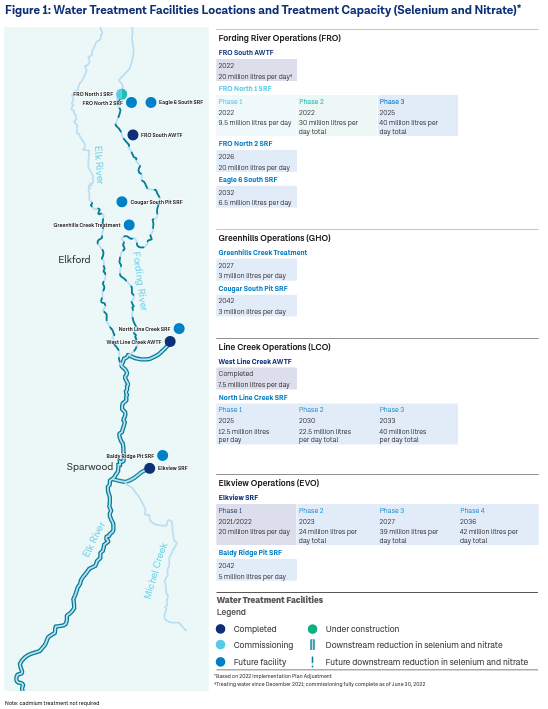
Source: EVR 2022 Implementation Plan
Water treatment facility operating status and key performance results
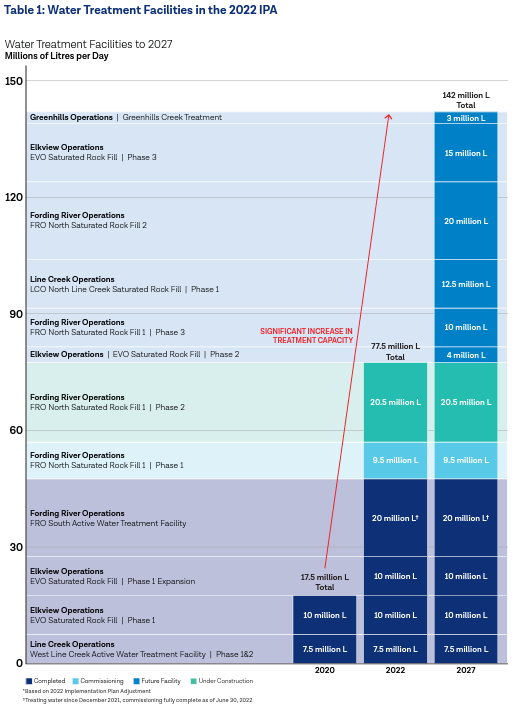
Source: EVR 2022 Implementation Plan
Clean water diversion
Clean water diversions are intended to minimize the amount of water in contact with mine sites, which reduces the amount of contact water that requires management. Two large clean water diversions are included in EVR’s Implementation Plan as they are specifically intended to reduce the amount of contact water in two creeks that require treatment.
In 2021, EVR finished construction of a 4.7 km clean water diversion (CWD) in Kilmarnock Creek at Fording River Operations. Up to 86,000 m3/day of clean water is now collected and conveyed around the waste rock piles in the Kilmarnock watershed and the FRO-S AWTF, and reintroduced back to the creek before it enters the Fording River. A 42,000 m3/day CWD is also planned to be operational by 2026 in the Line Creek watershed.
EVR is monitoring the Kilmarnock Creek CWD to better understand how surface and groundwater quality changes in response to the diversion. Preliminary results in 2022 are consistent with predictions.
Other water quality improvement updates
Source control
In 2022, EVR invested in improving mining practices and source control to reduce the amount of selenium, nitrate and sulphate being generated.
Source control efforts may reduce the amount of treatment facilities required in the future. They also support future mining practices that are more sustainable and less impactful than current practices.
Nitrate in the Elk Valley is released from explosives during blasting. Explosives often sit in drilled holes for several days prior to blasting. During this time nitrate can be lost into the surrounding rock, which is then blasted and moved to waste rock piles. To reduce the amount of nitrate entering the environment, EVR developed techniques and a plan for lining the blast holes to prevent leakage of nitrate from the explosives before they are blasted. They began this work in 2016 at Line Creek Operations. Since then, EVR has improved techniques and expanded the program.
In 2022, EVR lined approximately 90% of their blast holes at all mines, ranging from 67% at Elkview Operations to 100% at Line Creek Operations. EVR is continuing to research this topic to better understand exactly how effective this strategy is.
Selenium and sulphate are released from waste rock when it interacts with air and water. Natural bacteria that live in the waste rock piles have been shown to consume selenium and nitrate. These bacteria can remove the substances before they are released to the environment. These bacteria prefer conditions with low oxygen.
In 2021, EVR began construction of a waste rock pile at Elkview Operations that is designed to limit the amount of air within the waste rock pile. The limited air supply means that less selenium and sulphate should be released from the rock, and bacteria that consume these substances can also thrive. This source control method is called a suboxic zone (SOZ).
Construction of the 300 m wide, 1500 m long and 100 m tall SOZ waste rock pile was completed in October 2022. Many monitoring instruments are installed in the pile to measure changes in oxygen levels and water chemistry which are expected to occur over the next several years. Results from this monitoring will help determine if this is a viable technique for reducing the environmental impacts of mining in the Elk Valley.
Construction of a second full-sized SOZ trial at the Fording River Operations Swift North waste rock pile is tentatively planned to begin in 2023.




